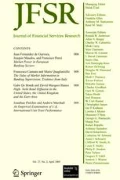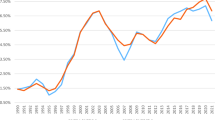Abstract
We examine the relation between capital and liquidity creation. This issue is interesting because of the potential impact on liquidity creation from tighter capital requirements such as those in Basel III. We perform Granger-causality tests in a dynamic GMM panel estimator framework on an exhaustive data set of Czech banks, which mainly includes small banks from 2000 to 2010. We observe a strong expansion in liquidity creation until the financial crisis that was mainly driven by large banks. We show that capital negatively Granger-causes liquidity creation in this industry, where majority of banks are small. But we also observe that liquidity creation Granger-causes a reduction in capital. These findings support the view that Basel III can reduce liquidity creation, but also that greater liquidity creation can reduce banks’ solvency. Thus, we show that this reverse causality generates a trade-off between the benefits of financial stability induced by stronger capital requirements and the benefits of increased liquidity creation.




Similar content being viewed by others
Notes
For instance, Bankscope does not provide the disaggregation of loans by category or by maturity for the vast majority of banks, which is of course needed for the computation of liquidity creation measures. Moreover, even within countries, the classifications of demand deposits, savings deposits, and time deposits are not consistent across banks.
Note that a large share of foreign bank ownership is common in Central and Eastern European countries. In addition to the Czech Republic, in Albania, Bosnia and Herzegovina, Bulgaria, Croatia, Estonia, FYR Macedonia, Georgia, Hungary, Lithuania, Montenegro, Romania, and Slovakia foreign banks own greater than 80 % of banks’ assets. These figures come from EBRD Structural Change Indicators.
See also Harding et al. (2013) on the effect on banks’ capital requirements and deposit insurance on banks’ capital structure.
In contrast to their paper, we use “fully mat fat” and “fully mat nonfat” measures, that is, we classify all items (not just loans) by the remaining maturity.
Twelve lags are used in the robustness check, please see section 4.3.
A building society is a special type of bank that provides home loans to households under specific conditions given in Act No. 96/1993 Coll., on Building Savings Schemes and State Support for Building Savings Schemes and its later amendments. Based on the volume of total assets, 4 building societies would be classified as medium-sized banks and one as a small bank.
See Brewer et al. (2008) on why the capital ratios vary across countries.
References
Allen F, Gale D (2004) Financial intermediaries and markets. Econometrica 72:1023–1061
Allen F, Santomero AM (1998) The theory of financial intermediation. J Bank Finance 21:1461–1485
Angelini P, Clerc L, Curdia V, Gambacorta L, Gerali A, Locarno A, Motto R, Roeger W, Van den Heuvel S, Vlček J (2011) Basel III: Long-term impact on economic performance and fluctuations. BIS Working Papers, n°338, BIS
Arellano M, Bond S (1991) Some Tests of Specification for Panel Data: Monte Carlo Evidence and an Application to Employment Equations. Rev Econ Stud 58:277–97
Arellano M, Bover O (1995) Another look at the instrumental-variable estimation of error-components. J Econometrics 68:29–52
Basel Committee on Banking Supervision (2010) Basel III: A global regulatory framework for more resilient banks and banking systems (revised June 2011), BIS
Berger A, Bouwman C (2009) Bank liquidity creation. Rev Financ Stud 22:3779–3837
Berger A, Bouwman C (2010) Bank liquidity creation, monetary policy and financial crises. Working Paper, Wharton Financial Institutions Center
Berger A, Bouwman C (2012) How does capital affect bank performance during financial crises? Case Western Reserve University, Working Paper
Berger A, Bouwman C, Kick T, Schaeck K (2012) Bank risk taking and liquidity creation following regulatory interventions and capital support. Working Paper
Bhattacharya S, Thakor AV (1993) Contemporary banking theory. J Financ Intermed 3:2–50
Blundell R, Bond S (1998) Initial conditions and moment restrictions in dynamic panel data models. J Econometrics 87:115–143
Boot AWA, Greenbaum S, Thakor AV (1993) Reputation and discretion in financial contracting. Amer Econ Rev 83:1165–1183
Brewer E III, Kaufman GG, Wall LD (2008) Bank capital ratios across countries: Why do they vary? J Financ Serv Res 34:177–201
Casu B, Girardone C (2009) Testing the relationship between competition and efficiency in banking: A panel data analysis. Econ Lett 105(1):134–137
Czech National Bank (2011) Financial stability report. June 2011
Diamond D, Rajan R (2001) Liquidity risk, liquidity creation, and financial fragility: A theory of banking. J Pol Economy 109:287–327
Fiordelisi F, Marques-Ibanez D, Molyneux P (2011) Efficiency and risk in European banking. J Bank Finance 35:1315–1326
Fungáčová Z, Weill L, Zhou M (2010) Bank capital, liquidity creation and deposit insurance. BOFIT Discussion Papers, Bank of Finland 17/10
Harding JP, Liang X, Ross SL (2013) Bank capital requirements, capital structure and regulation. J Financ Serv Res 43(2):127–148
Holmstrom B, Tirole J (1997) Financial intermediation, loanable funds, and the real sector. Q J Economics 112:663–691
Jokipii T, Milne A (2011) Bank capital buffer and risk adjustment decisions. J Financ Stability 7(3):165–178
Kashyap AK, Rajan RG, Stein JC (2002) Banks as liquidity providers: An explanation for the coexistence of lending and deposit-taking. J Finance 57:33–73
Lindquist K (2004) Banks’ buffer capital: How important is risk. J Int Money Financ 23:493–513
Pana E, Park J, Query T (2010) The impact of bank mergers on liquidity creation. J Risk Manag Financ Inst 4(1):74–96
Podpiera J, Weill L (2008) Bad luck or bad management? Emerging banking market experience. J Financ Stability 4:135–148
Pruteanu-Podpiera A, Weill L, Schobert F (2008) Banking competition and efficiency: A micro-data analysis on the Czech banking industry. Comp Econ Stud 50:253–273
Rauch C, Steffen S, Hackethal A, Tyrell M (2011) Determinants of bank liquidity creation. Working Paper, European School of Management and Technology
Repullo R (2004) Capital requirements, market power and risk-taking in banking. J Financ Intermed 13:156–182
Slovik P, Cournède B (2011) Macroeconomic impact of Basel III. Working Paper 844, OECD Economics Department
Windmeijer F (2005) A finite sample correction for the variance of linear efficient two-step GMM estimators. J Econometrics 126:25–51
Acknowledgements
We thank the Editor, an anonymous referee, Nikolas Breitkopf, Thomas Kick and seminar participants at the FMA European conference (Istanbul, Turkey), German Finance Association annual conference (Hannover, Germany), Euroconference – Society for the Study of Emerging Markets (Portoroz, Slovenia), 7th International Conference on Currency, Banking and International Finance (Bratislava, Slovakia), and the Czech National Bank for helpful comments. Our views do not necessarily represent those of the Czech National Bank. We acknowledge support from Czech Science Foundation grant no. P402/12/G097.
Author information
Authors and Affiliations
Corresponding author
Rights and permissions
About this article
Cite this article
Horváth, R., Seidler, J. & Weill, L. Bank Capital and Liquidity Creation: Granger-Causality Evidence. J Financ Serv Res 45, 341–361 (2014). https://doi.org/10.1007/s10693-013-0164-4
Received:
Revised:
Accepted:
Published:
Issue Date:
DOI: https://doi.org/10.1007/s10693-013-0164-4




